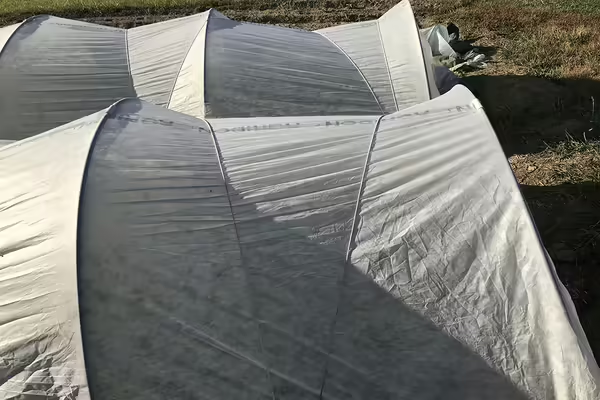
URBANA, Ill. — Harvest season in a vegetable garden doesn’t have to end so soon. Stretch growth with techniques that extend the typical growing season past the point where crops would normally be grown outdoors.
Protection from frosts can happen at either end of the growing season. A little preparation can go a long way in preserving and stretching crops that are already established.
Floating row covers
Covering the garden with a floating row cover of a spunbonded fabric offers increased protection in the fall as the reservoir of heat is larger. The fabric is breathable and allows sunlight and rainfall to reach the plants. Row covers are an easy method and not too labor-intensive.
Hoop-supported row covers
Some larger plants are more delicate in the garden. Hoops that support the fabric over the plants are used to protect the plants and are referred to as low tunnels. Low tunnels are usually 2 to 3 feet tall and can be made of a variety of materials with the added benefit of pest exclusion. Low tunnels also allow for heat to be released as needed. The supports need to be rigid for the potential weight from snowfall. Exposure to sunlight can cause some plastic tubing to degrade over time unless painted for protection.
Caterpillar tunnels
Although similar to low tunnels, caterpillar tunnels are larger, typically 6 to 8 feet tall. These tunnels are removable from the garden when not in use.
High tunnels
High tunnels or hoop houses provide a comfortable canopy for both the plant and the grower, as the height allows for standing within the structure. Row covers can also be used within high tunnels for added protection. There has been an increase in the commercial use of high tunnels for longer production, leading to increased interest by homeowners also seeking to extend the season. Commercial high tunnels can have some mobility but are essentially fixed structures.
Plant hardiness should be considered when choosing a season extension method. Cultivar selection must be investigated as certain cultivars are more tolerable of the higher temperatures and humidity conditions found in high tunnels. Consider the cost and returns when it comes to the operation's profitability. There are many different cost factors with the increased amount of protection.
For more research-based information on extending a garden season, connect with a local University of Illinois Extension county office at go.illinois.edu/ExtensionOffice. A brief guide, Growing Under High Tunnels in Illinois and the Midwest, is available for purchase at pubsplus.illinois.edu.
Andrew Holsinger is a Horticulture Educator with University of Illinois Extension, serving Christian, Jersey, Macoupin, and Montgomery counties. Gardeners Corner is a quarterly newsletter from gardening experts around the state. Each issue highlights best practices that will make your houseplants, landscape, or garden shine in any season. Join the Gardener’s Corner email list at go.illinois.edu/GCsubscribe for direct access to timely tips.
PHOTO CAPTION: Low tunnels secured to the ground to reduce the factor of the wind on the material. The photo in this article is available to download for media use. Photo by Andrew Holsinger, Illinois Extension.
Illinois Extension leads public outreach for University of Illinois by translating research into action plans that allow Illinois families, businesses, and community leaders to solve problems, make informed decisions, and adapt to changes and opportunities. Illinois Extension is part of the University of Illinois Urbana-Champaign College of Agricultural, Consumer and Environmental Sciences.